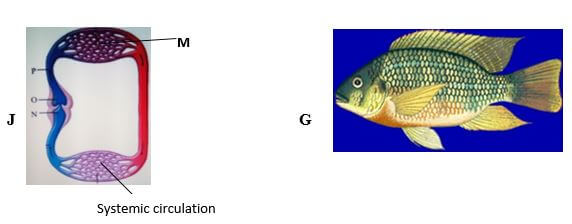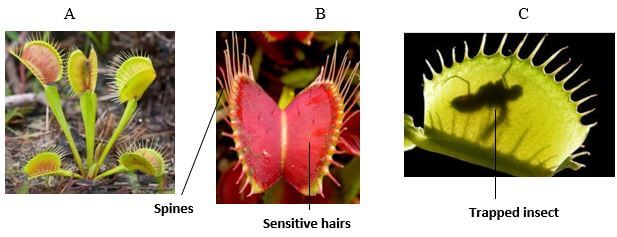INSTRUCTIONS TO CANDIDATES
- Write, index number and admission number in the spaces provided at the top of this page.
- Sign and write the date of examination in the spaces provided above.
- Answer ALL the questions.
- You are required to spend the first 15 minutes of the 1¾ hours allowed for this paper reading the whole paper carefully before commencing your work.
- Answers MUST be written in the spaces provided in this question paper.
- Additional pages MUST NOT be inserted.
- This paper consists of five (5) printed pages.
- Check the question paper to ascertain that all the pages are printed as indicated and that no questions are missing.
FOR EXAMINERS USE ONLY
|
Question |
Maximum Score |
Candidate’s Score |
|
1 |
13 |
|
|
2 |
11 |
|
|
3 |
16 |
|

QUESTIONS
- You are provided with Specimen K .Carefully cut a transverse section through specimen K using a scalpel provided.
-
- By observing one of the two halves of specimen K, Give two reasons to prove that specimen K has axile placentation (2mks)
- Squeeze some juice from specimen K into 100ml beaker provided and label it as juice K. using a portion of juice K, carry out the food test using the reagents provided and complete the table below. (NB preserve the remaining portion of juice K for use in question 2.) (8mks)
Food substance
Procedure
Observation
conclusion
- Name the deficiency disease that results from lack of the food substance present in juice K. (1mk)
- Highlight two symptoms of the disease named in (a) (iii) above . (2mks)
-
- Put 2cm3 of liquid labelled C into a test tube. Draw some of the juice from specimen K into a dropper. Add 4 drops of the juice into the test tube with solution C and shake.
-
- State your observation. (1mk)
- State the part of the human body where the process demonstrated above occurs and the enzyme that carries out the process.
Part of body... (1mk)
Enzyme.. (1mk) - Which gland produces the enzyme stated in (a)(ii) above? (1mk)
- Take a small amount of substance B provided and add to it 2cm3 of sodium hydrogen carbonate solution.
- State your observations (1mk)
- Which process in the body is illustrated above? (1mk)
- State the part of the body where the above process takes place (1mk)
- State two functions of substance B in the body (2mks
- Name two diseases of the circulatory system caused by excess cholesterol in food. (2mks)
-
-
- photograph J shows the circulatory system of organism represented by photograph G.

- Giving two reasons to your answer name the class to which specimen G belongs.
Class.... (1mk)
Reasons (2mk) - Name the part labelled: M... (1mk)
N.... (1mk)
O ... (1mk) - Giving one reason to your answer state the type of closed circulatory system shown by photograph J
Type of circulatory system.. (1mk)
Reason..(1mk) - State two features of specimen G that enhances its streamlined shape (2mks)
- Giving two reasons to your answer name the class to which specimen G belongs.
- Below are photographs of Venus flytrap (an insectivorous plant). Study them and answer the questions that follow.

- Name one major nutrient that is deficient in the soil where the above plant grows. (1mk)
- Name the type of response shown by plate C (1mk)
- Describe how the above plant trap the insect (4mks)
- photograph J shows the circulatory system of organism represented by photograph G.

MARKING SCHEME
-
-
-
- Edges of carpels fuse together to form a central placenta (2mks)
- Ovary wall divided into multiple loculi/chambers (accept between 4-10 chambers)
-
(8mks)Food substance
Procedure
Observation
conclusion
Starch
To a little amount of juice k in a test tube, add two drops of iodine solution
Brown colour of iodine solution remains
Starch absent
Vitamin C/ ascorbic acid)
To a little amount of DCPIP in a test tube, add juice k drop wise as you shake
DCPIP is decolorized
Vitamin C /ascorbic acid present
- Scurvy (1mk)
- –bleeding of gums (4 max 2)
-poor healing of wounds
-Anaemia
-swelling of the skin
-reduced resistance to infections/ susceptibility to infections
-
-
-
-
- Liquid C forms solid particles/liquid C curdles (1mk)
- - part of the body –stomach (1mk)
-Enzyme – Rennin reject Renin (1mk) - Gastric glands (1mk)
-
- Broken down into small droplets (1mk)
- Emulsification (1mk)
- Duodenum (1mk)
- –oxidized to release energy (2mks)
- Storage form of food
- Source of metabolic water
- shock absorbers on vital body organs accept correct example - -Atherosclerosis reject arteriosclerosis (2mks)
-thrombosis
-
-
-
- class - Pisces (1mk)
Reasons - presence of fins (4 max 2)
-body covered by scales
- presence of gills/ operculum
- presence of lateral line - M - gills (1mk)
N- auricle/atrium (1mk)
O- ventricle (1mk) - Type of closed circulatory system : Single circulatory system (1mk)
Reason : Blood flows to the heart once per complete circuit (1mk) - -scales facing backwards (1mk)
- absence of kneck (1mk)
- class - Pisces (1mk)
-
- Nitrogen (1mk)
- Thigmonasty/haptonasty (1mk)
- When the sensitive hairs on the leaf are touched (by the landing insect); the midrib cells losses turgidity rapidly; this makes the trap to spring inward; hence closing the leaf; with spines interlocking; (5 max 4)
-

CONFIDENTIAL
INSTRUCTIONS TO SCHOOL
- The information contained in this paper is to enable the head of school and the teacher in charge of Biology to make adequate preparations for this Biology Practical examination. NO ONE ELSE should have access to this paper or acquire knowledge of its contents. Great care MUST be taken to ensure that the information here does not reach the candidates either directly or indirect.
- The Biology teacher should note that it is his / her responsibility to ensure that each apparatus acquired for this examination agrees with the specifications given.
The question paper will not be opened in advance
Each candidate should be provided with the following:
- Specimen K (Orange fruit)
- About 3cm3 of substance B (olive oil)
- About 3cm3 of liquid C (fresh cow milk)
- About 2cm3 of 0.01% DCPIP (supplied with a dropper)
- About 2cm3 of Iodine solution
- About 2cm3 NaHC03 solution (supplied with a dropper)
- 6 test tubes in a test tube rack
- Distilled water in a wash bottle
- Scalpel
- Two 10ml measuring cylinder
- One 100ml beaker
- 2 Labels
- Two droppers
Download Biology Paper 3 Questions and Answers - Asumbi Girls Highschool Pre-Mock Exams May-June 2022.
Tap Here to Download for 50/-
Get on WhatsApp for 50/-
Why download?
- ✔ To read offline at any time.
- ✔ To Print at your convenience
- ✔ Share Easily with Friends / Students

